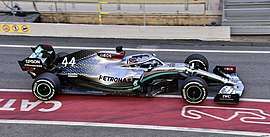Mercedes-AMG F1 W11 EQ Performance
The Mercedes-AMG F1 W11 EQ Performance is a Formula One racing car designed and constructed by the Mercedes-AMG Petronas Formula One Team under the direction of James Allison, Mike Elliott, John Owen and Geoff Willis to compete in the 2020 Formula One World Championship. The car is set to be driven by Lewis Hamilton and Valtteri Bottas.[6] The car was planned to make its competitive début at the 2020 Australian Grand Prix, but this was delayed when the race was cancelled and at least seven upcoming events on the calendar were postponed in response to the COVID-19 pandemic.[7][8] It is now expected to make its début at the 2020 Austrian Grand Prix.
 {{{image_title}}} A Mercedes-AMG F1 W11 EQ Performance, driven by Lewis Hamilton during pre-season testing. | |
| Category | Formula One |
|---|---|
| Constructor | Mercedes |
| Designer(s) | James Allison (Technical Director)[1] John Owen (Chief Designer)[2] Geoff Willis (Director of Engineering Process)[3] Mike Elliot (Technology Director)[4] |
| Predecessor | Mercedes AMG F1 W10 EQ Power+ |
| Technical specifications[5] | |
| Engine | Mercedes-AMG F1 M11 EQ Performance |
| Tyres | Pirelli P Zero (dry) Pirelli Cinturato (wet) |
| Competition history | |
| Notable entrants | Mercedes AMG Petronas F1 Team |
| Notable drivers | 44. Lewis Hamilton 77. Valtteri Bottas |
The pandemic also prompted the delay of technical regulations that had been planned for introduction in 2021. Under an agreement reached between teams and the Fédération Internationale de l'Automobile, 2020-specification cars—including the F1 W11 EQ Performance—will see their lifespan extended to compete in 2021.[9]
Initial design
The W11 has a system which Mercedes have coined Dual Axis Steering (DAS) which allows the driver to adjust the toe of the front wheels to optimise mechanical grip by pulling or pushing on the steering wheel. DAS will allow the drivers to warm the car's tyres more efficiently by having a zero toe but allows for better cornering ability by using a positive toe, a feature which will be of particular significance on circuits with long straights.[10] DAS will have to be removed from the car after the 2020 championship as the system will be banned for 2021.[11]
References
- "James Allison". Mercedes. Mercedes. 12 October 2017. Archived from the original on 28 April 2019. Retrieved 12 October 2017.
- "John Owen". Mercedes. Mercedes. Retrieved 9 September 2018.
- "Geoff Willis". Mercedes. Mercedes. Archived from the original on 28 April 2019. Retrieved 9 September 2018.
- name="Mike Elliott">"Mike Elliott". Mercedes. Mercedes. Archived from the original on 28 April 2019. Retrieved 9 September 2018.
- Coch, Mat (26 November 2018). "Pirelli to remain F1 tyre supplier until 2023". speedcafe.com. Speedcafe. Archived from the original on 21 August 2019. Retrieved 10 February 2019.
- "F1 – 2020 Provisional Entry List". Fédération Internationale de l'Automobile. 30 November 2019. Retrieved 30 November 2019.
- Coch, Mat (13 March 2020). "Confirmed: F1 cancelled at Australian Grand Prix". Retrieved 13 March 2020.
- "Bahrain and Vietnam Grands Prix postponed". formula1.com. 13 March 2020. Retrieved 13 March 2020.
- Herrero, Daniel (20 March 2020). "Formula 1's new regulations delayed until 2022". speedcafe.com. Speedcafe. Retrieved 20 March 2020.
- "DAS explained: what we know so far about Mercedes' steering system". www.formula1.com. Retrieved 21 February 2020.
- Benson, Andrew (31 March 2020). "Formula 1: Mercedes revolutionary 'DAS' steering remains banned for 2021". BBC Sport. Retrieved 31 March 2020.